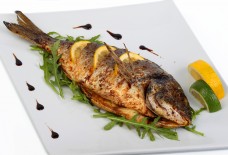When food is so much more than food (a recipe)
By Do’aa Mohaissen
When no one is looking, it’s hard to resist peeking into a sibling’s diary to read her pure feelings and thoughts, where she keeps her true self hidden (who wouldn’t like knowing what she really thinks of us?). It’s interesting how reading other people’s diaries allows you to see them from their own point of view, pouring their hearts out without need to lie or pretend.
Four years ago, I was looking for a notebook. Seeing a pile beside my sister’s bed, I was tempted me to search through it, even though I should have asked her permission first, of course. The first notebook was full of anime drawings. In the second one, I found a few papers neatly folded at the back and I carelessly unfolded the pages. There I found Kholoud’s unmistakable handwriting. I was taken aback; should I follow my curiosity or just put down the notebook and search another one? I couldn’t resist the temptation, and truth be told, I didn’t spend a lot of time fighting it. Struggling with my sister’s handwriting, I started reading.
A few minutes later, I closed my eyes and breathed. It was the first time I realized what the act of cooking meant to my sister. She wrote about how she loves creating new dishes, but my brothers never appreciate or congratulate her. “I long for feedback!” she wrote heartbreakingly.
Unlike my sister –and most of my female friends—I consider cooking to be a dull, dreary chore, accompanied by an endless need to wash plates. Reading my sister’s diary showed me that cooking can mean so much more than producing food to eat. And the fact that no one cared to ask my sister for her ingredients or to chat with her about how she succeeded in creating so much flavor in one dish made me deeply sad. I find it very frustrating that women in Gaza are defined by their ability to cook well, as expressed in the old saying, “The way to a man’s heart is through his stomach.” However, I finally understood that for many women, it can be very enriching.
For me, though, I have never tried making a main course by myself. The truth? It terrifies me! You need to follow rules; otherwise, adding too much salt, for example, could ruin the whole dish!
Yesterday, I asked Mama to make my favorite dish, macaroni béchamel, for ghada (lunch), but she insisted I do it myself. I’ve never tried to make it, so I asked my older sister for help.
Macaroni béchamel is my favorite dish, although I don’t recall when I announced that to everyone and started suggesting Mom make it every single day. I’ve never grown tired of its simple, delicious taste. In the beginning, Mom used to follow an exact recipe, but after several years, making macaroni béchamel became more spontaneous. Now I tease her about how she spends less than 15 minutes in the kitchen preparing macaroni béchamel, when she used to spend 30 or 40 minutes.
How to make macaroni béchamel
To prepare this dish that holds such a special place in my heart, you first boil macaroni well and then put it aside while the vegetables are prepared. Second, chop some onion and heat some oil in a pan. Stir in the onion until it becomes golden in color. If you like garlic, you can add some to the onion, but if you don’t, it’s ok! Add some chopped tomatoes as well and continue stirring.
Saute the onions, garlic and tomatoes.When all of these ingredients are well cooked, add minced beef and stir the mixture until the meat turns brown. If you have any vegetables in the fridge, go and get them! You can add peas, corn and carrot. You also can add sliced black olives, mushrooms and different-colored peppers (the colors make the hashwa [stuffing] vibrant). Add some tomato paste and, when the ingredients are well combined, put the mixture aside in a dish while you make the béchamel.
For the béchamel, you need four spoons of butter, four cups of milk, seven spoons of flour and a bit of salt. Melt the butter, then add the flour. Keep stirring until the flour and butter are well mixed, then add the milk and salt and keep stirring until the mixture thickens.
To prepare the final dish, line a baking dish with a layer of macaroni, pour some béchamel over it, then add the beef and vegetables you prepared earlier. Add another layer of macaroni and then pour the rest of the béchamel over it until the macaroni is covered completely.
Place the dish in the oven and wait until the top layer turns a beautiful golden color. You can add mozzarella as you wish. And there you have it….my favorite “comfort food.”
Do’aa Mohaisen, 18, is a student of English language and literature at the Islamic University of Gaza, and a regular contributor to We Are Not Numbers. She says her life revolves around reading, writing and “endless discussions about language.”
To see more stories, visit We Are Not Numbers.









